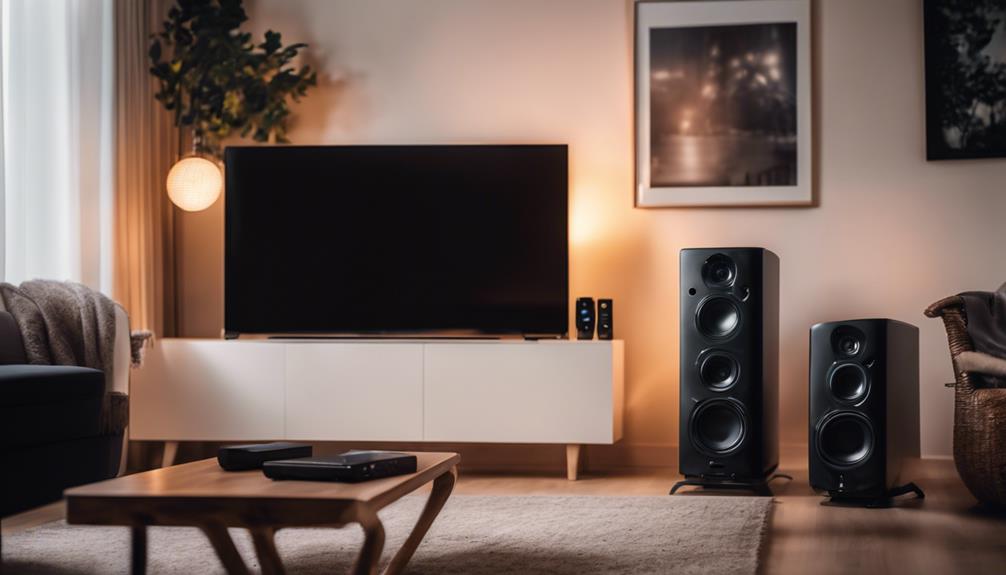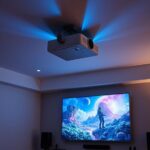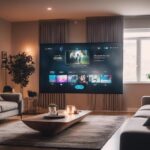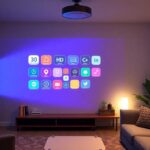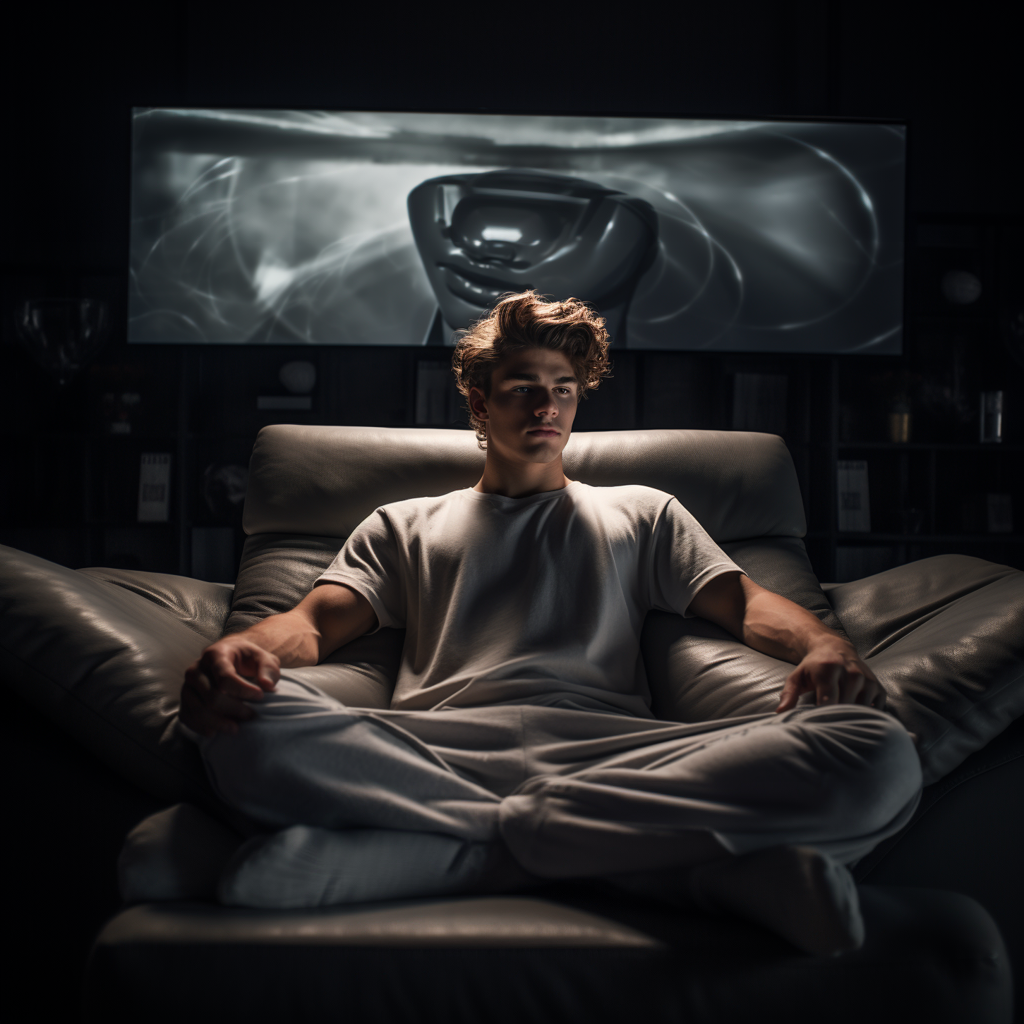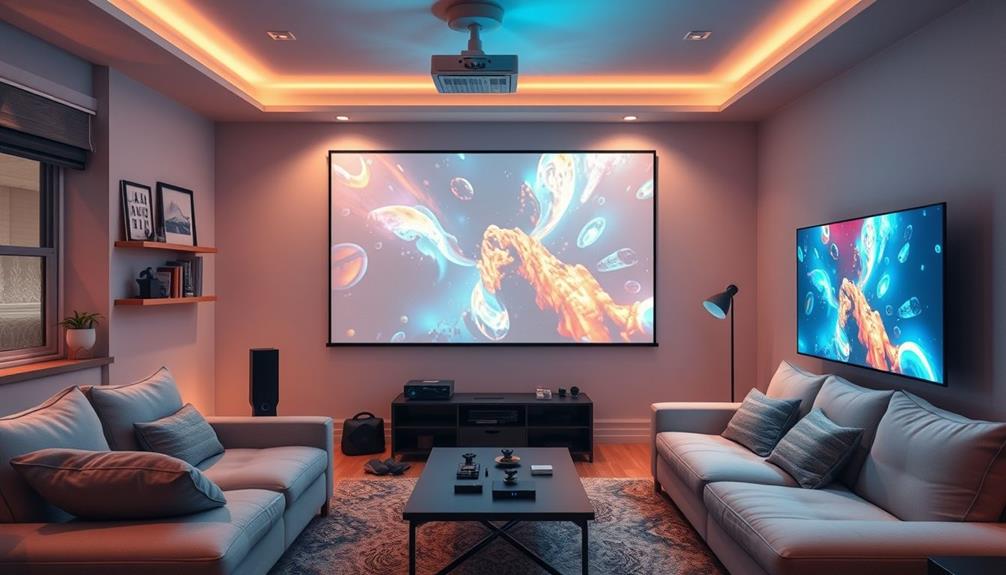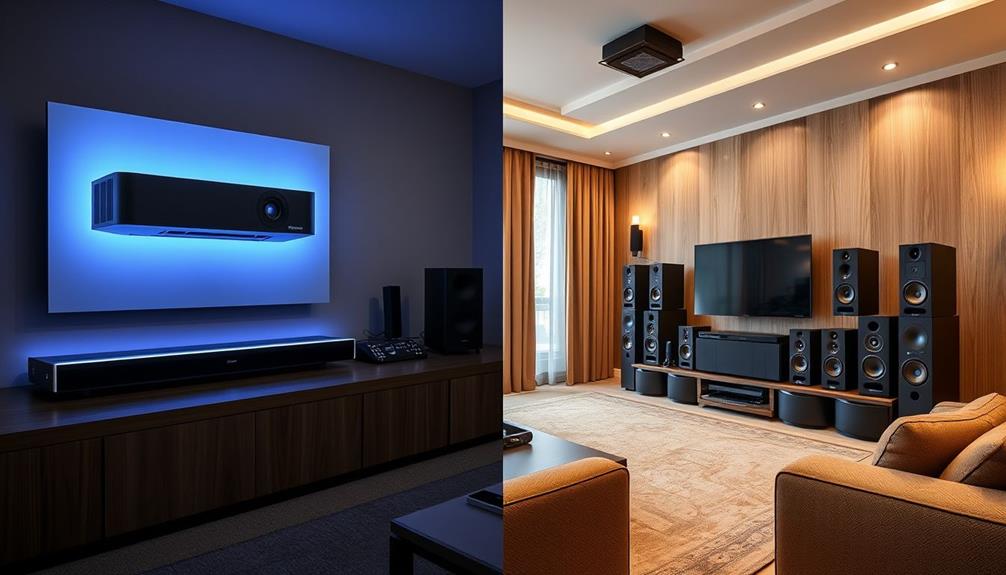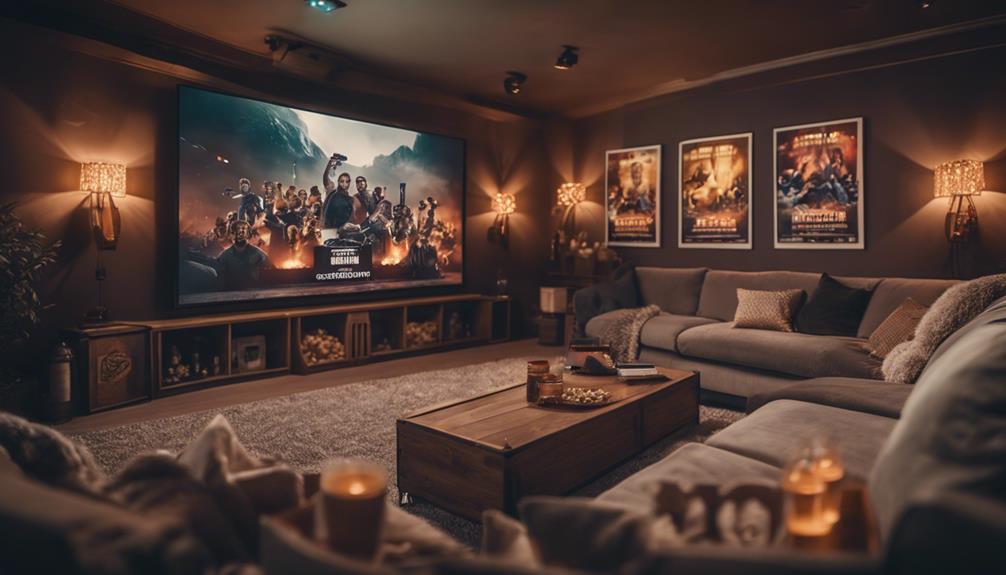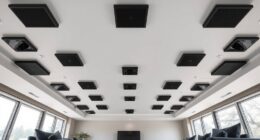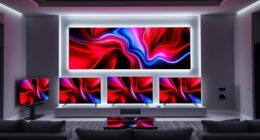Implementing voice control in your home cinema setup makes everything easier and more enjoyable. You can use systems like Amazon Alexa, Google Assistant, or Apple Siri to manage your devices hands-free. Start by ensuring all your gadgets are on the same Wi-Fi network and download the necessary apps. Next, create routines to control multiple devices with one command, like "movie time." Don't forget to check compatibility with your audio setup. By setting up custom commands, you'll tailor your experience to fit your preferences. Discover how to maximize this system for a smarter home cinematic experience.
Key Takeaways
- Ensure all devices are connected to the same Wi-Fi network for seamless voice control integration.
- Use compatible voice assistants like Amazon Alexa, Google Assistant, or Apple Siri for efficient management of your home cinema setup.
- Create custom voice commands to streamline multiple tasks, enhancing convenience during movie nights.
- Regularly update firmware and software for all devices to maintain optimal performance and compatibility.
Overview of Voice Control
Voice control technology offers you a convenient way to manage your home cinema setup with just your voice, simplifying the way you enjoy entertainment. By utilizing voice control, you can easily execute commands to operate various smart devices within your home. Major platforms like Amazon Alexa and Google Assistant allow you to control your entertainment systems hands-free, enhancing your viewing experience.
Imagine telling your device to "turn on the TV" or "play my favorite movie," all without reaching for a remote. This level of accessibility is especially beneficial for individuals with mobility challenges. You can control playback functions such as power, volume, and media selection through simple voice commands, making home cinema more enjoyable for everyone.
Setting up voice control is straightforward. Connect your devices to a central hub or app, ensuring all components are on the same Wi-Fi network for peak functionality. Once set up, you can streamline tasks, allowing you to multitask effortlessly—adjusting settings or finding a movie while preparing food or tidying up. Embrace this technology for a more interactive and enjoyable home cinema experience.
Compatible Voice Control Systems
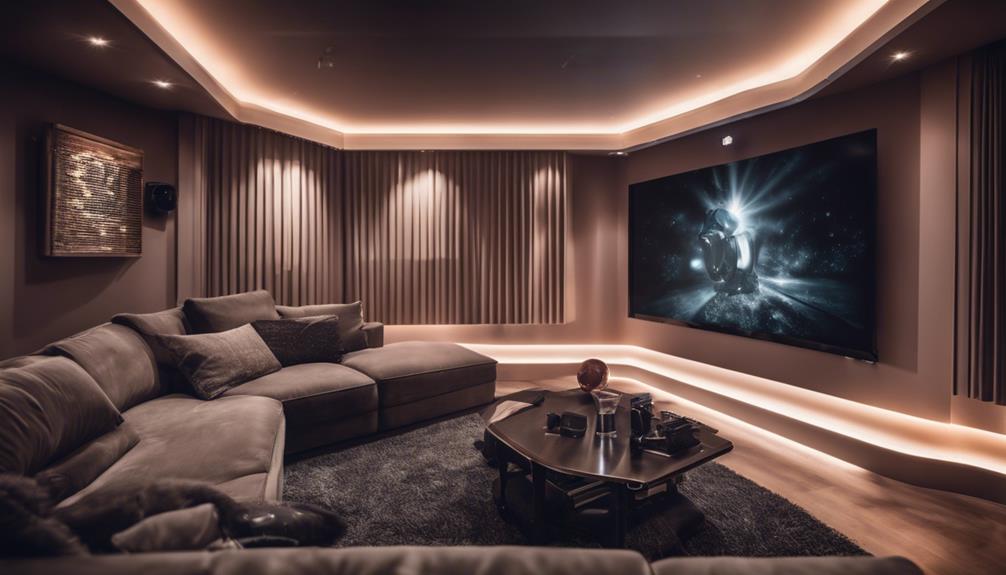
Several compatible voice control systems can elevate your home cinema experience by seamlessly integrating with a variety of devices. Among these, Amazon Alexa, Google Assistant, and Apple Siri stand out, each bringing unique functionalities to your setup.
With Amazon Alexa, you can easily control devices like Fire TV and Echo speakers using simple voice commands. It's perfect for those who love streaming services and want quick access to their favorite shows or music.
On the other hand, Google Assistant pairs beautifully with Google Chromecast and many smart TVs, allowing you to navigate your home cinema with just your voice.
If you're an Apple user, Siri is your go-to choice. It works well with Apple TV and other HomeKit-compatible accessories, providing a unified experience across your devices.
Additionally, both Alexa and Google Assistant support various streaming services like Spotify and Pandora, enabling effortless music playback.
Many smart home devices, including soundbars and receivers, are designed to work with specific voice control systems, enhancing your overall home cinema experience.
Setting Up Your Devices
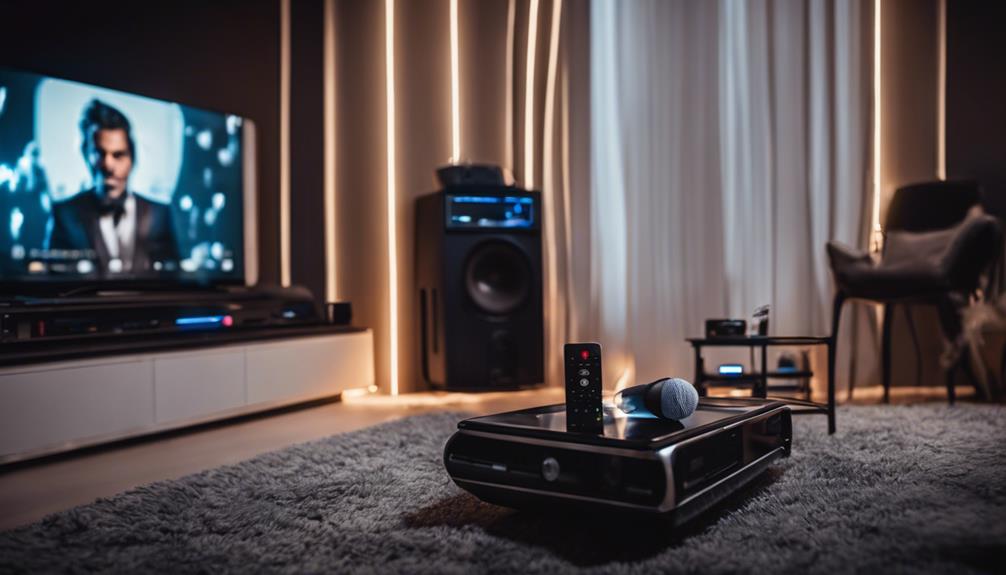
To enjoy the full benefits of compatible voice control systems in your home cinema, start by setting up all your devices to work seamlessly together. First, confirm that all your devices, including your TV, smart speakers, and media streamers, are connected to the same Wi-Fi network. This connection is vital for effective voice control integration.
Next, download the appropriate voice assistant app—either Amazon Alexa or Google Home—on your smartphone. This app will help you link and manage your devices efficiently. For your TV, use Google Chromecast or Apple AirPlay 2 to facilitate voice commands like "Turn on the TV" or "Play [movie name]."
To enhance audio control, integrate your sound system with Bluetooth or AUX connections. This setup allows you to use voice commands for volume adjustments and playback.
Lastly, make sure to regularly check for firmware updates on all devices to maintain peak performance and compatibility.
| Device Type | Connection Method |
|---|---|
| TV | Google Chromecast |
| Sound System | Bluetooth/AUX |
| Voice Assistant | Alexa / Google Home |
Creating Voice Control Routines
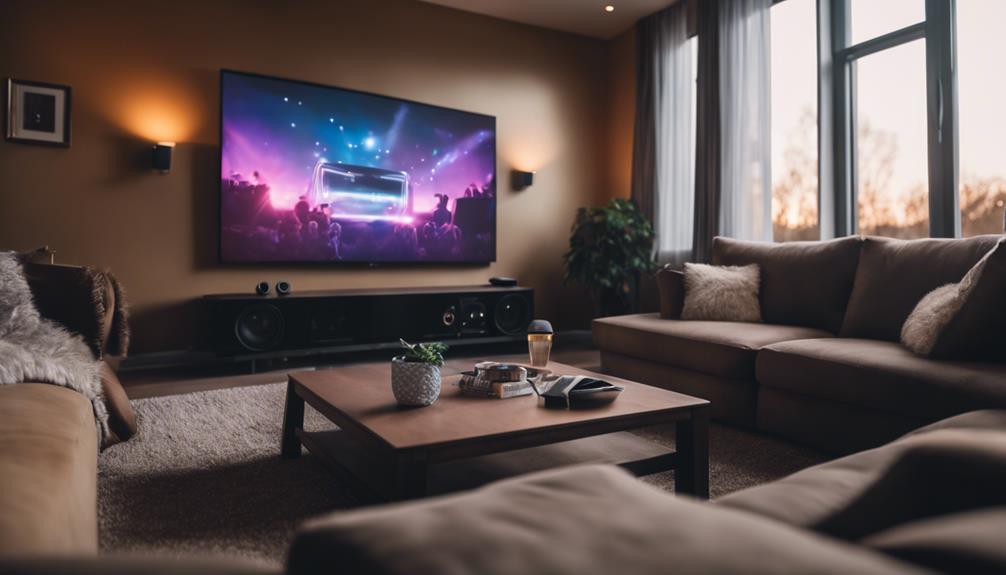
Creating customized routines can elevate your home cinema experience, allowing you to control multiple devices with a single command.
Using the Alexa or Google Home apps, you can set up routines that combine actions like dimming lights, turning on the TV, and starting your favorite movie. Just say, "Alexa, it's movie time," and watch as your smart home transforms for the perfect viewing experience.
You can also create automated experiences, such as a "Good Night" routine that switches off audio equipment and dims lights, making it easy to wind down.
Make sure your voice control device is placed where it can hear you clearly, as this enhances command recognition.
Regularly updating your voice assistant software is essential for accessing new features and improving voice commands.
For those looking to take it a step further, consider utilizing IFTTT (If This, Then That) to establish advanced routines that respond to specific triggers, integrating your home cinema system with other smart home devices seamlessly.
This way, you can enjoy a truly immersive and convenient experience tailored to your preferences.
Connecting Music Services

When you want to connect music services to your voice control system, it's crucial to know which platforms are supported.
You'll find that linking your accounts is a straightforward process, and there are plenty of voice command examples to make playback effortless.
Let's explore the setup and how to maximize your music experience with hands-free control.
Supported Music Platforms
Voice control systems seamlessly integrate with popular music platforms like Spotify and Pandora, allowing you to effortlessly enjoy your favorite tunes through simple voice commands.
With devices like Amazon Echo and Google Home, you can easily access high-fidelity audio and smart sound capabilities for an elevated listening experience.
When using Amazon Echo devices, you can connect via AUX jacks or wirelessly to your existing sound systems, making it simple to stream music. Just say commands to play music, and you'll have instant access to your playlists.
For Google Home devices, you can enhance your music streaming by connecting through Chromecast or Bluetooth, ensuring an impressive audio experience.
Setting custom voice commands for Spotify and Pandora is another fantastic feature. You can initiate playback with phrases like "Play my favorite playlist" or "Shuffle my songs." This level of personalization not only adds convenience but also makes it easier to enjoy your music without needing to reach for a remote.
Setup Process Overview
Connecting music services like Spotify and Pandora to your smart speaker is a straightforward process that enhances your voice control experience.
Start by confirming your Amazon Echo or Google Home is linked to the respective music service through its specific app. For Alexa, open the Amazon Alexa app, navigate to the "Music & Podcasts" section, and link your preferred service. Set it as your default to streamline music playback using voice commands.
If you're using Google Home, access the Google Home app, head to the "Music" section, and select your desired streaming service. This setup process is essential for seamless integration. Make sure your smart speaker is connected to the same Wi-Fi network as your music streaming device. This connection guarantees smooth operation and better voice command recognition.
Once everything's linked, you can effortlessly control music playback. For instance, simply say, "Play [song/artist] on Spotify" or "Play my playlist on Pandora," and enjoy your favorite tunes hands-free.
Voice Command Examples
You can easily initiate music playback by using specific voice commands tailored to your favorite streaming services. With voice control systems like Alexa and Google Assistant built-in, you can enjoy a seamless listening experience in your smart home theatre.
Here are some examples of voice commands to play your favorite tracks:
- "Play my chill playlist on Spotify."
- "Play [artist name] on Pandora."
By integrating Amazon Echo devices or Google Home, you can connect your speakers wirelessly or via wired connections, ensuring high-quality audio playback. These devices allow you to control your music entirely through voice commands, making it easier to set the mood without lifting a finger.
To enhance your experience further, you can link your voice assistants to music services through their apps. This way, you can create custom voice commands for specific playlists or genres, tailoring your listening experience to suit your preferences.
Whether you're hosting a party or enjoying a quiet evening, voice commands to play your favorite tunes will transform how you enjoy music in your home cinema.
Basic Voice Commands
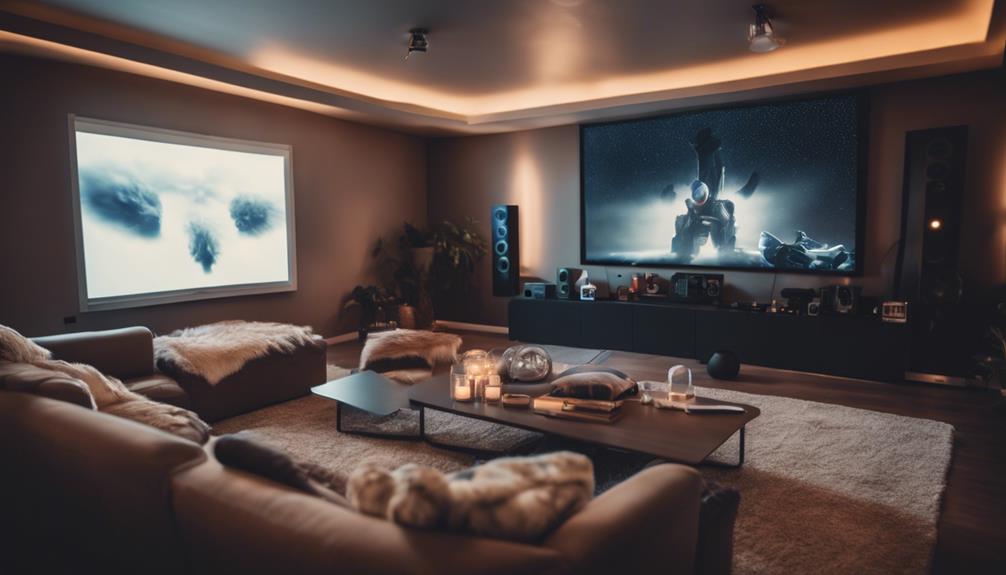
When you set up voice control for your home cinema, knowing basic commands can make your experience seamless and enjoyable.
You can easily turn on devices, play your favorite movies, or adjust the volume without lifting a finger.
Plus, customizing commands to fit your specific needs can enhance convenience even further.
Common Voice Commands
Basic voice commands like "Turn on the TV" and "Play [movie/series name]" make it easy to control your home cinema effortlessly. With voice control technology, you can engage with your home entertainment setup using just your voice. Both Alexa and Google Assistant can recognize simple phrases, allowing you to operate various compatible devices.
Here are some common voice commands you might find useful:
- "Set volume to 50%"
- "Pause"
These commands streamline your experience by letting you initiate streaming services and specific content without fumbling with remotes. You can simply speak your requests, and your voice assistant will handle the rest.
To guarantee accurate command recognition, it's important to link your devices properly and enunciate clearly. This way, you can enjoy a seamless interaction with your home cinema system.
Custom Command Creation
Creating custom voice commands for your home cinema setup can greatly enhance your viewing experience by streamlining multiple tasks into a single phrase. With the Amazon Alexa app or Google Home app, you can easily create commands that suit your needs.
For instance, you might set a command like "Movie Time" to automatically dim the lights, turn on the TV, and start your favorite streaming service. This not only improves convenience but also amplifies your cinematic experience. Here's a quick overview of some basic commands you can create:
| Command | Action |
|---|---|
| Movie Time | Dim lights, turn on TV, play movie |
| Game Night | Turn on console, switch TV input |
| Relax Mode | Lower volume, adjust lighting |
Voice assistants can recognize simple commands like "Turn on the projector" or "Play [movie name]." This custom command creation enhances accessibility, allowing users with mobility challenges to control their system effortlessly. As voice assistant software updates roll out, expect even more options to boost your user experience.
Enhancing Audio Control
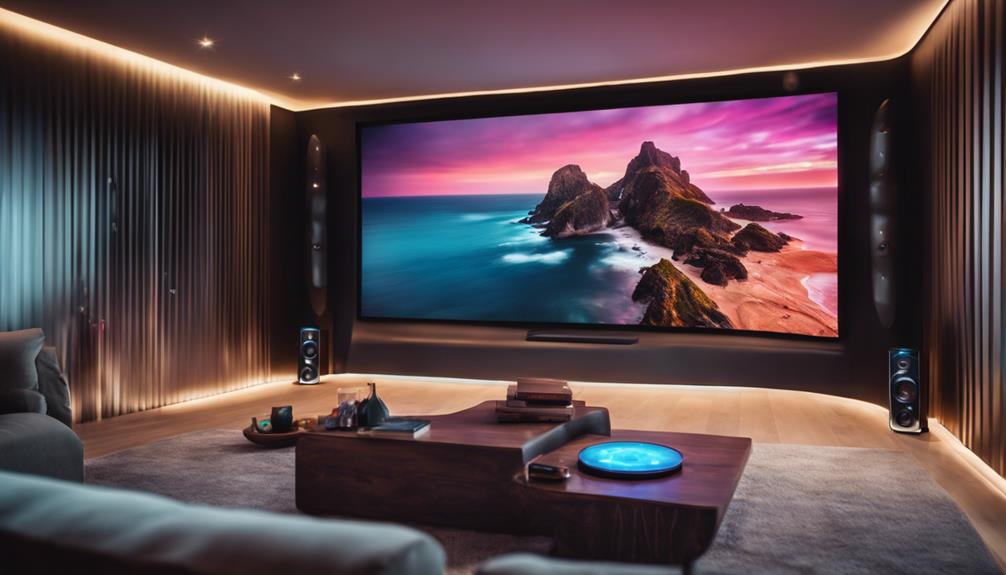
Integrating voice control systems like Amazon Alexa and Google Assistant into your home cinema setup considerably enhances your audio control, allowing you to manage volume, playback, and source selection effortlessly. With smart assistants at your command, you can enjoy a seamless entertainment experience.
Here are some key benefits to evaluate:
- Voice Commands: Use simple voice prompts to control your audio devices, making it easy to adjust settings without lifting a finger.
- Streaming Services: Access popular services like Spotify and Pandora with your voice, enabling you to initiate your favorite playlists or discover new music effortlessly.
Troubleshooting Common Issues

While enjoying the convenience of voice control in your home cinema, you might encounter some common issues that can hinder your experience.
First, confirm your voice control system and all devices are powered on and connected to the same Wi-Fi network. This is vital for smooth operation.
If you find that your voice commands are unresponsive, try rebooting your smart speaker or device—this often solves many connectivity problems.
Another key step in troubleshooting is to regularly check for software updates on both your voice assistant applications and connected devices. Outdated software can lead to compatibility issues.
Additionally, verify the microphone functionality on your smart speaker; accidental muting can prevent it from recognizing your commands.
If you continue to experience issues, consult the user manuals for specific troubleshooting steps related to your devices.
Remember, confirming you have compatible wireless connections is essential for seamless integration.
Future Trends in Voice Control
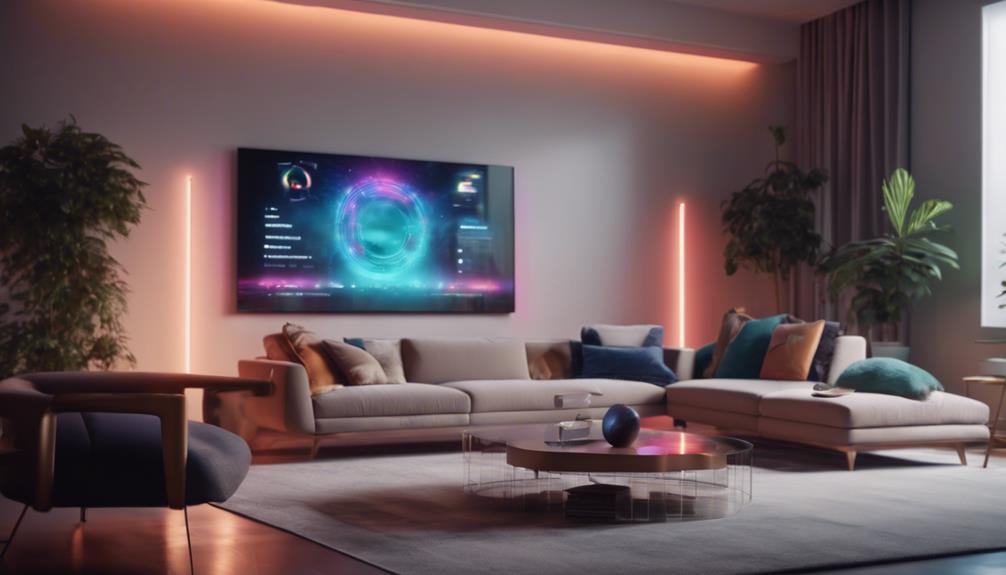
As you look ahead, AI integration in voice control will redefine how you interact with your home cinema.
Expect more personalized experiences that adapt to your preferences, making your commands feel intuitive.
Plus, seamless compatibility with a range of devices will simplify your setup, allowing you to enjoy entertainment effortlessly.
AI Integration Advancements
How will the future of AI-driven voice control reshape your home cinema experience? As technology advances, you'll find that the integration of voice assistants like Alexa or Google Assistant will enhance your control over home entertainment components. Expect more sophisticated voice command systems that utilize natural language processing capabilities, allowing you to issue complex, conversational commands.
Here are a few trends to look forward to:
- Seamless Integration: Home entertainment components will work harmoniously with AI-driven voice control technology, simplifying your setup.
- Personalized Command Execution: Continuous learning algorithms will recognize your unique speech patterns and preferences, offering you a tailored experience.
These advancements signal a shift towards smarter home solutions, where your voice commands will lead to intuitive and efficient interactions with your entertainment environment.
Embrace the future, and get ready for a cinema experience that not only responds to you but truly understands what you want.
Personalized User Interactions
The evolution of voice control technology is set to create personalized user interactions that adapt to your unique preferences and habits in home cinema experiences.
Imagine your home theater responding seamlessly to your voice commands, whether you're using Alexa or Google Home. This future promises enhanced personalized interactions, allowing your system to learn your audio commanded preferences, making movie nights feel tailored just for you.
With advancements in AI, these systems will develop custom routines that align with your habits. You could say, "It's movie time," and watch as the lights dim, the audio adjusts, and your favorite streaming service launches automatically.
The voice control features will evolve to understand context and nuances, providing a seamless user experience that feels intuitive and natural.
Integrating with other smart home devices will further enhance these interactions. Picture controlling your lighting, audio, and video settings simultaneously through personalized voice commands.
This level of customization won't only elevate your home cinema experience but also make it more enjoyable, engaging, and efficient, ensuring every movie night is a cinematic delight tailored to you.
Seamless Device Compatibility
With voice control technology evolving rapidly, you'll soon find that integrating various smart home devices into your home cinema setup becomes effortless and intuitive. As systems like Alexa and Google Assistant expand their device compatibility, the potential for seamless interoperability is growing. This means you can control your entire entertainment setup with simple voice commands, streamlining your viewing experience.
Here are a few exciting future trends in seamless device compatibility:
- AI-driven voice recognition: This technology will learn your preferences, making interactions even more personalized.
- Enhanced interoperability: Expect devices to work together effortlessly, allowing for complex commands that control multiple functions at once.
As you adopt these advancements, you'll transform your home cinema into a truly smart home environment. With voice control, you can manage everything from lighting to audio with just your voice, making it easier than ever to enjoy your favorite movies and shows.
Get ready for a more immersive and convenient entertainment experience!
Personalizing Your Experience

Personalizing your home cinema experience transforms movie nights into immersive events that cater to your unique preferences.
With voice control, you can create custom voice commands that initiate specific actions. For example, saying "Alexa, start movie night" can dim the lights and turn on your projector simultaneously, setting the perfect atmosphere.
Utilizing voice assistant routines further enhances your experience by allowing you to execute multiple commands with a single phrase. Want music during intermissions? Integrate services like Spotify or Pandora, and simply say, "Play background music," to customize your soundtrack effortlessly.
Customizing room names in your smart home apps streamlines the process, making commands clearer and easier to follow. Instead of fumbling with settings, just say, "Play music in the living room," and enjoy seamless control.
Additionally, adjusting audio settings through voice commands helps cater to your auditory preferences. Saying, "Set volume to 75%," guarantees you're always comfortable, enhancing your overall viewing experience.
Frequently Asked Questions
How Do I Set up Voice Control?
To set up voice control, connect all devices to the same Wi-Fi, download the voice assistant app, and follow the prompts to pair your devices. Don't forget to check for software updates regularly.
Can I Make My TV Voice Control?
If you're looking to sprinkle a bit of magic into your TV experience, you can absolutely turn your television into a voice-responsive wonder. Just guarantee it's compatible and follow the setup instructions to get started.
Can Alexa Control My Stereo Receiver?
Yes, Alexa can control your stereo receiver if it's compatible. Just connect it to the same Wi-Fi network, enable the necessary skills in the Alexa app, and you're ready to use voice commands.
What Is Home Voice Controller?
Think of a home voice controller as your personal conductor, orchestrating your entertainment experience. It's a device that lets you control your TV, sound systems, and more, all through simple voice commands for ultimate convenience.
Conclusion
As you navigate the domain of home cinema voice control, think of yourself as a conductor leading an orchestra.
Each device responds to your commands like musicians following your baton, creating a symphony of sound and convenience.
With a few simple setups, you transform your living room into a harmonious haven.
Embrace this technology and let your voice be the maestro, shaping your cinematic experience into a masterpiece that captivates both you and your guests.
Tom is the Editor-in-Chief of 1home Theatre Projector, a website that provides news and reviews on the best home cinema experiences. With over 10 years of experience in the industry, Tom knows what makes a great home theatre projector and wants to make it easy for everyone to build the perfect setup for their needs. When he’s not busy writing or testing projectors, Tom enjoys watching classic films and spending time with his family.
